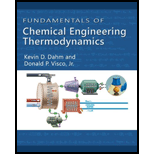
For an ethylene glycol n-butyl ether (1) + water (2) system at 340 K with 80% by mass water, determine if the system is one stable liquid phase or two stable liquid phases at equilibrium. If the latter, provide the mass fraction of the co-existing phases and the amount of each phase.
Interpretation:
Find out the stable phase of the system and mass fraction of the co-existing phases.
Concept introduction:
Mass to mole conversion is given as follows:
Here, mass of the component is
Molecular weight of ethylene glycol n-butyl ether is
Molecular weight of water is
The composition of this mixture in terms of percentage is given as follows:
Here, mole of the component is
The overall material balance.
Here, overall number of moles is N, and moles in phases
The ethylene glycol n-butyl ether material balance.
Explanation of Solution
Given information:
Mass of the ethylene glycol -butyl ether is
Mass of water is
Mass to moles conversion for ethylene glycol n-butyl ether is given as follows,
Substitute 0.20 g for
Mass to moles conversion for water is given as follows,
Substitute 0.80 g for
Calculate the composition of this mixture in terms of percentage.
Substitute 0.0016 mole for
Thus the composition of this mixture in terms of moles is then 3.67%.
Refer Figure 13-4 “Liquid-Liquid equilibrium of the ethylene glycol n-butyl ether + water system at 1 bar” at 340 K and the calculated composition mixture at 0.036703, The mixture is
Two stable liquid phase.
Thus, the given composition lies inside of the two phase region for the given temperature, so the given system is Two stable liquid phase.
Calculate the mass fraction of the liquid phase
Refer Figure 13-4, “Liquid-Liquid equilibrium of the ethylene glycol n-butyl ether + water system at 1 bar”,
In phase diagram, move horizontally towards left at 340 K to find out the liquid phase of the composition (
Thus, the mass fraction for phase
Calculate the mass fraction of the liquid phase
Refer Figure 13-4, “Liquid-Liquid equilibrium of the ethylene glycol n-butyl ether + water system at 1 bar”,
In phase diagram, move horizontally towards left at 340 K to find out the liquid phase of the composition (
Thus, the mass fraction for phase
Write the overall material balance.
Substitute
Write the ethylene glycol n-butyl ether material balance.
Substitute 0.0367 for
Substitute equation (5) in equation (7).
Substitute
Mole to mass conversion
| components |
moles |
| ||
| components 1 (phase | 0.01 | 0.038435 | 118.17 | 0.0454 |
| components 2 (phase | 0.99 | 0.038435 | 18.01 | 0.685 |
| components 1 (phase | 0.18 | 0.007165 | 118.17 | 0.1524 |
| components 2 (phase | 0.82 | 0.007165 | 18.01 | 0.1058 |
Write the expression for the composition for phase
Substitute 0.0454 g for
Write the expression for the composition for phase
Substitute 0.0454 g for
Write the expression for the total mass of phase
Substitute 0.0454 g for
Thus, the amount in phase
Similarly, calculating the mass of the
Calculate the composition for phase
Substitute 0.1524 g for
Calculate the composition for phase
Substitute 0.1524 g for
Calculate the total mass of phase
Substitute 0.1524 g for
Thus, the amount in phase
Want to see more full solutions like this?
Chapter 13 Solutions
Fundamentals of Chemical Engineering Thermodynamics (MindTap Course List)
 Introduction to Chemical Engineering Thermodynami...Chemical EngineeringISBN:9781259696527Author:J.M. Smith Termodinamica en ingenieria quimica, Hendrick C Van Ness, Michael Abbott, Mark SwihartPublisher:McGraw-Hill Education
Introduction to Chemical Engineering Thermodynami...Chemical EngineeringISBN:9781259696527Author:J.M. Smith Termodinamica en ingenieria quimica, Hendrick C Van Ness, Michael Abbott, Mark SwihartPublisher:McGraw-Hill Education Elementary Principles of Chemical Processes, Bind...Chemical EngineeringISBN:9781118431221Author:Richard M. Felder, Ronald W. Rousseau, Lisa G. BullardPublisher:WILEY
Elementary Principles of Chemical Processes, Bind...Chemical EngineeringISBN:9781118431221Author:Richard M. Felder, Ronald W. Rousseau, Lisa G. BullardPublisher:WILEY Elements of Chemical Reaction Engineering (5th Ed...Chemical EngineeringISBN:9780133887518Author:H. Scott FoglerPublisher:Prentice Hall
Elements of Chemical Reaction Engineering (5th Ed...Chemical EngineeringISBN:9780133887518Author:H. Scott FoglerPublisher:Prentice Hall
 Industrial Plastics: Theory and ApplicationsChemical EngineeringISBN:9781285061238Author:Lokensgard, ErikPublisher:Delmar Cengage Learning
Industrial Plastics: Theory and ApplicationsChemical EngineeringISBN:9781285061238Author:Lokensgard, ErikPublisher:Delmar Cengage Learning Unit Operations of Chemical EngineeringChemical EngineeringISBN:9780072848236Author:Warren McCabe, Julian C. Smith, Peter HarriottPublisher:McGraw-Hill Companies, The
Unit Operations of Chemical EngineeringChemical EngineeringISBN:9780072848236Author:Warren McCabe, Julian C. Smith, Peter HarriottPublisher:McGraw-Hill Companies, The





